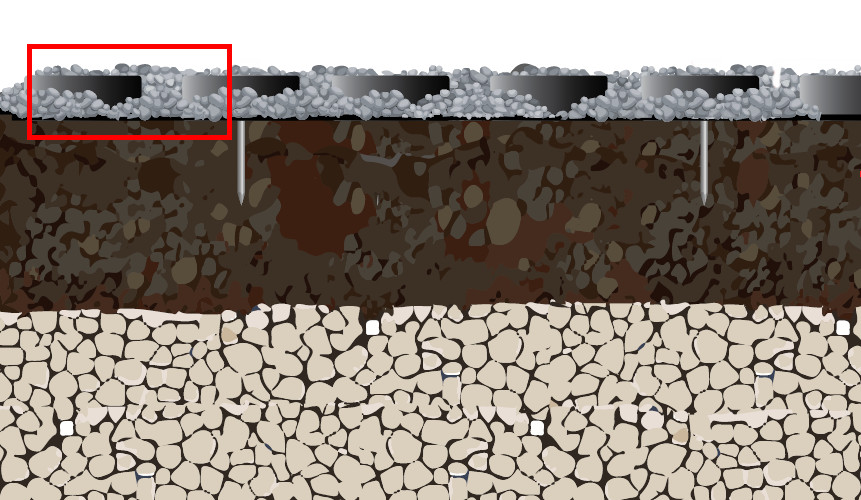The Mechanics of Porous Paving: How It All Works
Porous paving is changing the way people think about managing stormwater and enhancing urban landscapes. One of the many benefits of porous paving solutions like Grasspave2 and Gravelpave2 from Invisible Structures, is their ability to allow rainwater to infiltrate the surface and into the ground below. They minimize runoff without requiring cost- and resource- intensive infrastructure.
Upon a closer look, porous paving is a well-designed system that is more than what happens on the surface level. The fill materials on top like grass and gravel and the base course underneath the pavers play important roles. These components work together to manage stormwater and transfer loads to the ground effectively.
Understanding how a porous paving system operates and what materials are suitable can inform proper installation, which is key to fully capitalizing on the potential of the system. So, how does porous paving work?
The grass- or gravel-filled porous pavers are the first level the system
The process of water infiltration begins with the surface layer. Porous paving solutions like Grasspave2 or Gravelpave2 have 92 percent void spaces, which is about three times that of alternative permeable paver options like concrete paver blocks as well as porous asphalt and concrete. A larger volume of void space directly translates to a better drainage capacity, which is further enhanced with the fill material, be it grass or gravel.
In application, porous pavers hold the fill material, which filters the stormwater, allowing it to pass through the spaces between them and into the ground below. Because the proportion of void spaces influences performance, alternative permeable paving options (8-20 percent void space) drain at about 6.4 inches per square foot per hour. Whereas Grasspave2, which is a porous pavement filled with grass, drains 32.5 inches of water per square foot per hour and Gravelpave2, a porous paver filled with gravel, has a drainage rate of 38.5 inches per square foot per hour.

A strong and stable base course is crucial to a porous paving system
Once the water passes through the fill material and flexible porous paver, it continues to flow downward and reaches the base course. A base course is a layer of gravel or aggregate installed between the subgrade (the natural ground) and the surface layer of a pavement structure. Serving dual roles of a foundation and a reservoir, the base layer helps infiltrate water into the water table or water detention system while also evenly distributing the load of the activities on the surface. In doing so, it prevents pavers from shifting or settling over time.
Because the base course will influence the stability and longevity of a porous paving system, its depth recommendation will vary by use— from a very shallow 2-inches for pedestrian and light stormwater capture, to 12-inches deep for heavy stormwater drainage.
Selecting the best materials for porous paving system based on site- and project- specific requirements
Because the base course is essentially the backbone of the pavement structure, choosing the right materials underneath a porous paver is important for its stability and performance. Factors like local climate and soil conditions significantly influence this choice, as they affect freeze-thaw cycles, soil types and water table levels. Additionally, project-specific requirements, such as anticipated traffic loads and aesthetic preferences, will also play a role in the decision-making.
Commonly used base course material includes sandy gravel and crush stone aggregate. Their well-graded particle size allows excellent drainage and load-bearing capacity, making both popular options. Similarly, open-graded aggregate is particularly favored beneath porous paving in high-flow areas, owing to its ability to promote rapid water infiltration.

Maximizing the benefits of a porous paving system
Combined with the right base materials and proper installation, porous paving systems like Grasspave2 and Gravelpave2 are effective solutions in managing stormwater and creating more sustainable urban landscapes. By understanding how each component of the system works—from the surface layer to the base course— landscape designers and contractors can maximize the benefits of these systems, ensuring long-lasting performance.
Next steps
Looking to bring the benefits of porous paving systems to your projects? The options extend beyond just pavements. For instance, the NRG stadium in Houston, Texas, home to the Texans, the city’s NFL team, features seven acres of Grasspave2 covering parking lots and designated areas reserved for emergency vehicle access.
With a compressive strength of 2,295,000 psf, Grasspave2 and Gravelpave2 are both ideal for areas with low-speed vehicular traffic, such as fire lanes, parking lots and driveways. Explore the range of applications our products make possible.
